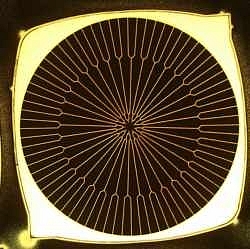German scientists set new record of solar cell efficiency - 39,7%
At 39.7% efficiency for a multijunction solar cell, researchers at the Fraunhofer Institute for Solar Energy Systems ISE in Freiburg have exceeded their own efficiency record of 37.6%, which they achieved in July of this year.
At 39.7% efficiency for a multijunction solar cell, researchers at the Fraunhofer Institute for Solar Energy Systems ISE in Freiburg have exceeded their own efficiency record of 37.6%, which they achieved in July of this year.
The result was reached using multijunction solar cells made out of III-V semiconductors. III-V semiconductor multijunction solar cells are used in concentrating photovoltaic (PV) technology for solar power stations.
"We have improved the contact structures of our solar cells," says Frank Dimroth, Head of the III-V - Epitaxy and Solar Cells Group at Fraunhofer ISE. "As a result, using the same semiconductor structures, we now achieve the higher efficiency when converting sunlight into electricity."
In these concentrating PV applications, optimal efficiency is achieved between 300 - 600 suns, that is, at a sunlight concentration factor of 300 - 600. The metallization of the front side makes the main difference for different concentration factors. In the front grid the current is conducted through a network of thin wires (see Figure 1, lead image, top of page) from the middle of the solar cell to the edge, where it is then picked up by a 50 µm gold wire.
Particularly under concentrated sunlight, the structure of this metal network is decisive. For one, the metal wires must be big enough to transport, with low resistance, the large currents that are generated under concentrated sunlight. On the other hand, the wires must be as small as possible since the sunlight cannot penetrate through metal and thus the cell area covered by metal cannot be used for the electrical conversion.
The result was reached using multijunction solar cells made out of III-V semiconductors. III-V semiconductor multijunction solar cells are used in concentrating photovoltaic (PV) technology for solar power stations.
"We have improved the contact structures of our solar cells," says Frank Dimroth, Head of the III-V - Epitaxy and Solar Cells Group at Fraunhofer ISE. "As a result, using the same semiconductor structures, we now achieve the higher efficiency when converting sunlight into electricity."
In these concentrating PV applications, optimal efficiency is achieved between 300 - 600 suns, that is, at a sunlight concentration factor of 300 - 600. The metallization of the front side makes the main difference for different concentration factors. In the front grid the current is conducted through a network of thin wires (see Figure 1, lead image, top of page) from the middle of the solar cell to the edge, where it is then picked up by a 50 µm gold wire.
Particularly under concentrated sunlight, the structure of this metal network is decisive. For one, the metal wires must be big enough to transport, with low resistance, the large currents that are generated under concentrated sunlight. On the other hand, the wires must be as small as possible since the sunlight cannot penetrate through metal and thus the cell area covered by metal cannot be used for the electrical conversion.

